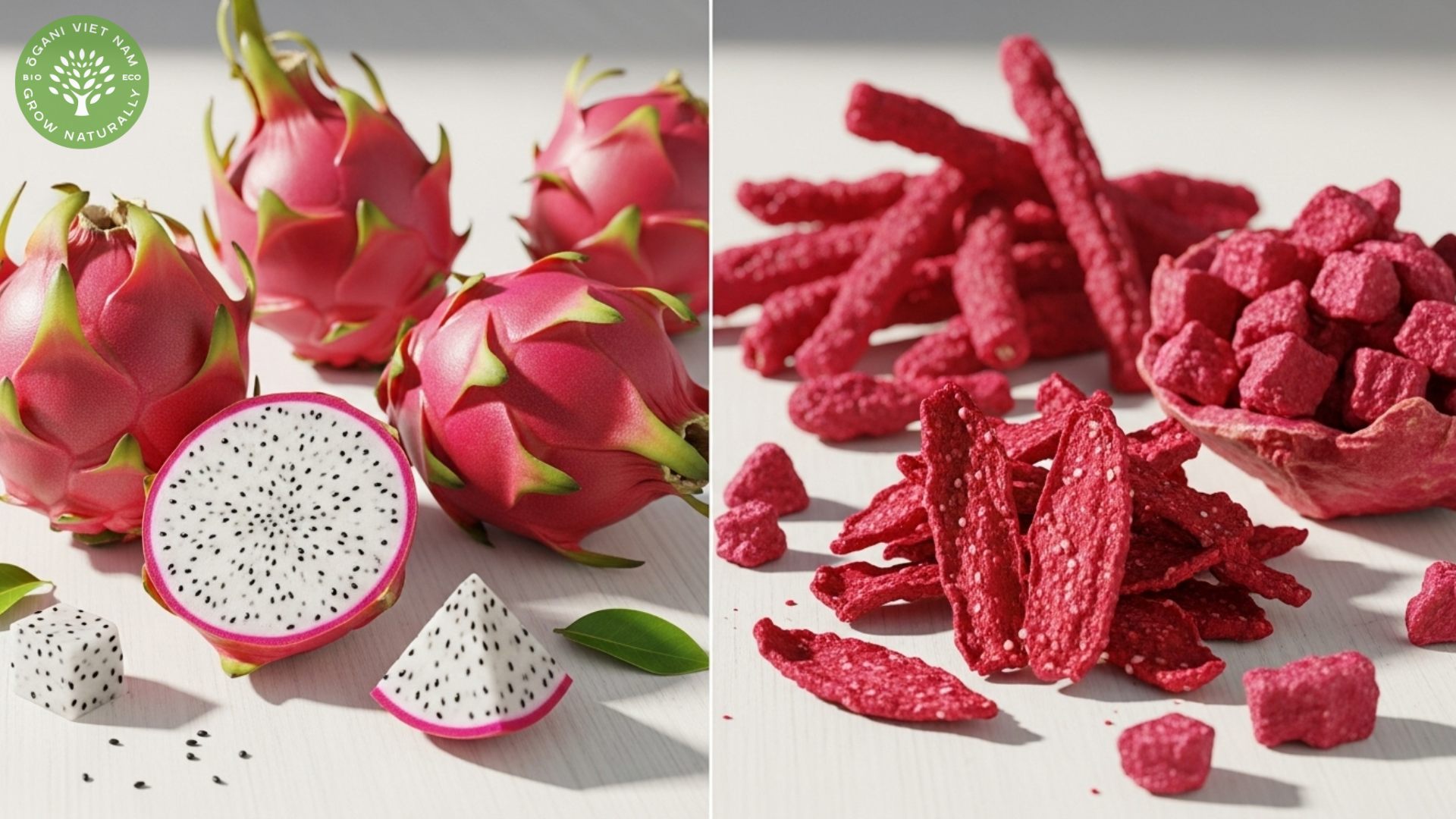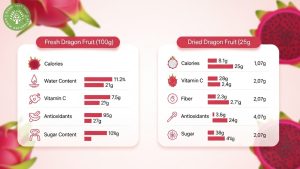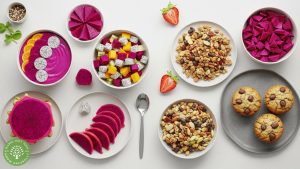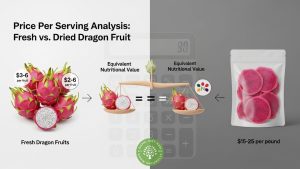
Dried red dragon fruit packs the goodness of nutrients in every bite and stays fresh much longer, while the fresh fruit wins with its juicy water content and delicate texture. Both are great for your health, yet each plays a different role in your daily diet.
At Ogani VN, we’ve guided many customers in choosing between the two. With years of working directly with trusted farms and premium tropical fruits, we know it often comes down to lifestyle, nutrition goals, and of course, personal taste.
Dried bred dragon fruit vs fresh: nutritional showdown
The biggest difference between dried red dragon fruit and its fresh counterpart comes down to nutrient density. Once the fruit is dehydrated, the water is removed, leaving behind a more concentrated source of vitamins, minerals, and antioxidants in every bite.
Fresh dragon fruit, on the other hand, is about 90% water. That’s why it’s so refreshing and hydrating, with just around 60 calories per 100 grams. While the water content naturally dilutes the nutrients, each serving still gives you a good dose of vitamin C, iron, magnesium, and fiber — all wrapped up in its juicy, delicate flesh.
By contrast, dried red dragon fruit delivers 3–4 times the nutrients gram for gram. Just 25 grams of dried fruit can match the nutritional value of 100 grams of fresh fruit. The trade-off is in the sugar content: you’ll get around 15–20 grams of natural sugars in dried fruit compared to 7–8 grams in the same amount of fresh.
What really stands out in the dried version is its antioxidant strength. Betalains — the pigments that give dragon fruit its striking red color — become even more concentrated through dehydration, which may boost their anti-inflammatory benefits. Some heat-sensitive vitamins, like vitamin C, can drop during the drying process, but freeze-dried varieties keep up to 95% of their original nutrient profile.

Texture and taste: dried bred dragon fruit vs fresh varieties
Fresh dragon fruit offers a one-of-a-kind eating experience, often likened to a mix of kiwi and pear. Its soft, almost creamy flesh is dotted with tiny black seeds that add just the right amount of crunch. The flavor leans toward gentle sweetness with a light, tropical touch.
Dried red dragon fruit, on the other hand, is a completely different adventure. Once dehydrated, the texture shifts to chewy or crisp depending on how it’s processed, and the taste becomes bolder, with sweetness far more concentrated. Many of our customers describe the dried version as tasting “more tropical” — a snack that feels both satisfying and naturally indulgent.
Fresh dragon fruit applications
Fresh dragon fruit shines in smoothie bowls, fruit salads, and refreshing drinks where hydration matters most. Its gentle flavor blends easily without overwhelming other ingredients, making it a perfect choice for breakfast bowls or light desserts. For those trying tropical fruits for the first time, we often suggest starting with fresh dragon fruit — it’s approachable, mild, and instantly enjoyable.
Dried dragon fruit applications
Dried dragon fruit is wonderfully versatile. It adds a burst of color and natural sweetness to trail mixes, granola, or baked goods, and it’s equally satisfying eaten on its own as a wholesome snack. Because the flavor is concentrated, even small portions pack a big impact. Plus, when soaked, dried dragon fruit softens and rehydrates beautifully, opening up even more ways to use it in both dry and wet recipes.

Storage comparison: dried bred dragon fruit vs fresh convenience
Storage needs also play a big role in how people choose between the two. Fresh dragon fruit usually keeps for 3–5 days at room temperature once it ripens, or up to two weeks when stored in the fridge. Because the fruit continues to ripen after harvest, timing is important if you want to enjoy it at its peak.
Dried red dragon fruit stands out for its long-lasting convenience. When kept in airtight containers, it can stay fresh for 12–18 months without refrigeration — perfect for office snacks, travel, or even emergency supplies. Although the price per pound is higher, the extended shelf life often makes it the more economical choice in the long run.
The ease of use is another big advantage. While fresh dragon fruit needs peeling, slicing, and quick consumption, the dried version is ready to enjoy straight from the bag. Portion-controlled and completely mess-free, it’s a snack designed for busy lifestyles where convenience often outweighs the added processing cost.

Price analysis: dried bred dragon fruit vs fresh economics
Pricing also marks a clear difference between the two. Fresh dragon fruit usually sells for about $3–6 per fruit, depending on size and season. Because it doesn’t continue ripening once picked, the quality you find in stores can vary — sometimes leading to less-than-satisfying purchases.
By contrast, dried red dragon fruit comes with a higher upfront price, typically $15–25 per pound. But it’s worth noting that a single pound of dried fruit equals 3–4 pounds of fresh fruit. When you look at it per serving of actual fruit content — and factor in the reduced waste from spoilage — the costs often balance out more than expected.

Availability is another key factor to consider. Fresh dragon fruit is bound by seasons and geography, so in many regions it arrives after long-distance shipping — a process that can affect both quality and nutritional value. Dried dragon fruit, on the other hand, is available year-round with steady quality standards, giving customers reliable access no matter the season.
Frequently Asked Questions
Which form is more nutritious?
Both fresh and dried dragon fruit bring solid health benefits, but in different ways. Fresh fruit is hydrating and delivers nutrients gently, while dried fruit packs concentrated nutrition into smaller portions. The right choice depends on your diet goals and how you like to enjoy your fruit.
Can dried dragon fruit replace fresh in recipes?
Not exactly. Dried dragon fruit has a chewier texture and stronger sweetness, making it ideal for baked goods, trail mixes, or snacks. For smoothies or fresh-style dishes, it works best if rehydrated first — or used as a colorful garnish.
How much dried equals fresh nutritionally?
Around 25–30 grams of dried dragon fruit gives you similar nutrients to 100 grams of fresh. Keep in mind, though, the dried version comes with more concentrated sugars and calories, so portion control is key if you’re watching your intake.
Does processing reduce health benefits?
It depends on the method. Freeze-drying keeps 90–95% of the nutrients, while traditional dehydration can lower heat-sensitive vitamins like vitamin C. Still, antioxidants and fiber often become more concentrated in dried fruit, giving you plenty of nutritional value per serving.
Which dragon fruit form fits your lifestyle ?
The choice between fresh and dried red dragon fruit really comes down to lifestyle, nutrition goals, and taste. Fresh dragon fruit is perfect when you want hydration, a delicate flavor, and the joy of eating fruit straight from the peel. Dried dragon fruit, meanwhile, offers unbeatable convenience, concentrated nutrients, and the ability to store for months without losing its charm.
At Ogani VN, we believe the best approach is to keep both on hand — fresh dragon fruit for those refreshing moments and dried fruit for quick snacks or versatile cooking. That way, you’ll always enjoy the best of what dragon fruit has to offer, no matter the season or your schedule.
Ready to try the difference for yourself? Explore our carefully sourced fresh and dried dragon fruit selections at Ogani VN — delivered straight to your door with guaranteed quality and freshness.
Read more:
-
- Dried Red Dragon Fruit vs Fresh: Color, Nutrition & When to Use Each
- Dried Unsweetened Mango: Healthy Snack Guide
- Organic Dried Mango: Your Complete Guide To Healthy Snacking
- How to Store Dried Mango & Maximize Shelf Life (Pantry, Fridge, Freezer)
- Dried Mango vs Freeze‑Dried Mango: Nutrition, Texture & Best Uses

